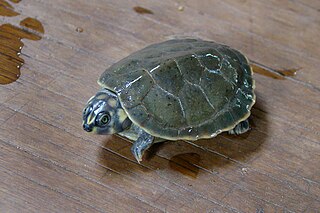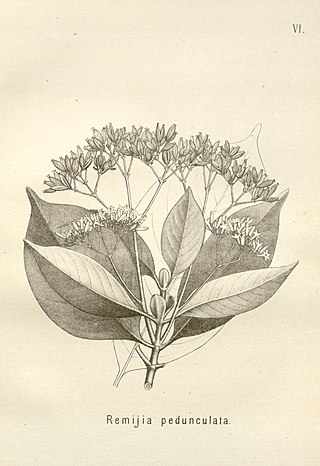
The Rio Negro, or Guainía as it is known in its upper part, is the largest left tributary of the Amazon River, the largest blackwater river in the world, and one of the world's ten largest rivers by average discharge. Despite its high flow, the Rio Negro has a low sediment load.

Richard Spruce was an English botanist specializing in bryology. One of the great Victorian botanical explorers, Spruce spent 15 years exploring the Amazon from the Andes to its mouth, and was one of the very first Europeans to observe many of the places where he collected specimens. Spruce discovered and named a number of new plant species, and corresponded with some of the leading botanists of the nineteenth century.

Hevea is a genus of flowering plants in the spurge family, Euphorbiaceae, with about ten members. It is also one of many names used commercially for the wood of the most economically important rubber tree, H. brasiliensis. The genus is native to tropical South America but is widely cultivated in other tropical countries and naturalized in several of them. It was first described in 1775.

Parkia is a genus of flowering plants in the family Fabaceae. It belongs to the mimosoid clade of the subfamily Caesalpinioideae. Several species are known as African locust bean.

Psychotria is a genus of flowering plants in the family Rubiaceae. It contains 1,645 species and is therefore one of the largest genera of flowering plants. The genus has a pantropical distribution and members of the genus are small understorey trees in tropical forests. Some species are endangered or facing extinction due to deforestation, especially species of central Africa and the Pacific.

The six-tubercled Amazon River turtle or six-tubercled river turtle is a species of turtle in the family Podocnemididae.

Malouetia is a genus of plants in the family Apocynaceae, first described as a genus in 1844. It is native to Africa, South America, Central America, and the West Indies.

Chiococca is a genus of flowering plants in the family Rubiaceae. It currently holds 23 species that are native to Florida, Texas, Mexico, Central America, much of South America, the West Indies, and the islands of Galápagos and Fernando de Noronha.

Coprosma nitida, the mountain currant or shining currant, is a shrub species endemic to south-east Australia. It is a shrub with small, glossy leaves, occasional spines on the end of its branchlets, and small bright red-orange fruits.

Duroia is a genus of flowering plants in the family Rubiaceae. The genus is found from Costa Rica to tropical South America.

Retiniphyllum is a genus of flowering plants in the family Rubiaceae and contains 20 species. It is the only genus in the tribe Retiniphylleae. The representatives are shrubs or small trees that grow in white sand soils in tropical South America. They are mainly distributed in the Guayana Region (Venezuela) but also occur in the Amazon Basin, the eastern Andes and central and eastern Brasil.
Capirona is a monotypic genus of flowering plants in the family Rubiaceae. The genus contains only one species, viz. Capirona decorticans, which is native to northern South America. It has been reported from French Guiana, Guyana, Suriname, Venezuela, Colombia, Ecuador, Perú, and northern Brazil.
Cinchonopsis is a monotypic genus of flowering plants in the family Rubiaceae containing the single species Cinchonopsis amazonica. It is native to South America, where it occurs in the Amazon basin to the eastern slopes of the Andes.

Ciliosemina is a genus of flowering plants in the family Rubiaceae. There are two recognized species distributed in South America from the eastern Andes to the Amazon basin.

Ferdinandusa is a genus of flowering plants in the family Rubiaceae, native to the American tropics.

The Japurá–Solimões–Negro moist forests (NT0132) is an ecoregion of tropical moist broad leaf forest in the Amazon biome.

Hevea spruceana is a species of rubber tree in the genus Hevea, belonging to the family Euphorbiaceae. It is native to the rainforests of northern Brazil and Guyana. It is named in honour of the English botanist Richard Spruce who spent the years 1849 to 1864 exploring the Amazon basin and sending botanical specimens back to Europe.

Cynanchica nitida is a species of flowering plant in the family Rubiaceae. It is a subshrub native to Greece's east Aegean Islands and to Turkey.

Pagamea is a genus of flowering plants in the family Rubiaceae, native to northern South America. Shrubs or small trees, they are specialists in the Amazonian white-sand forests.

Mollia is a genus of flowering plants belonging to the family Malvaceae. It is within the Grewioideae subfamily, and the Grewieae tribe.

















